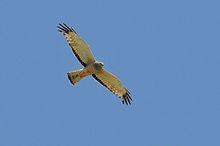Cinereous Harrier
| Cinereous Harrier | |
|---|---|
 | |
| Male flying in Rio Grande do Sul, Brazil | |
| Conservation status | |
| Scientific classification | |
| Kingdom: | Animalia |
| Phylum: | Chordata |
| Class: | Aves |
| Order: | Falconiformes (or Accipitriformes, q.v.) |
| Family: | Accipitridae |
| Genus: | Circus |
| Species: | C. cinereus |
| Binomial name | |
| Circus cinereus (Vieillot, 1816) | |
The Cinereous Harrier (Circus cinereus) is a South American bird of prey of the harrier family. Its breeding range extends from the Tierra del Fuego through Argentina and Chile to Bolivia, Paraguayand southern Brasil; and across the Andes north to Colombia.
The term cinereous describes its colouration. The male's plumage is dark grey above with black wingtips and a white rump. The underparts are pale grey, with a rufous streaked belly. The female's plumage is brown above, with a white rump, and cream coloured underneath, with a streaked belly similar to the males. The female is larger than the male with an average size of 46 cm (18 in) compared to the male's 40 cm (16 in). The wingspan is 90–115 cm (35–45 in). Since the 44.5 cm (17.5 in) tail comprises about 56% of this raptor's total length, this species ties with the Long-tailed Hawk as the raptor with the longest tail relative to its body size.
This bird can be found in different open habitats, ranging from lowland marshes to the AndeanAltiplano at a maximum altitude of 4500 metres. Like other harriers it nests on the ground. It is usually considered to be sedentary.
Its diet is variable, due to a wide range and variety of habitats. Its usual prey are small rodents and birds, reptiles, amphibians and insects.

No comments:
Post a Comment